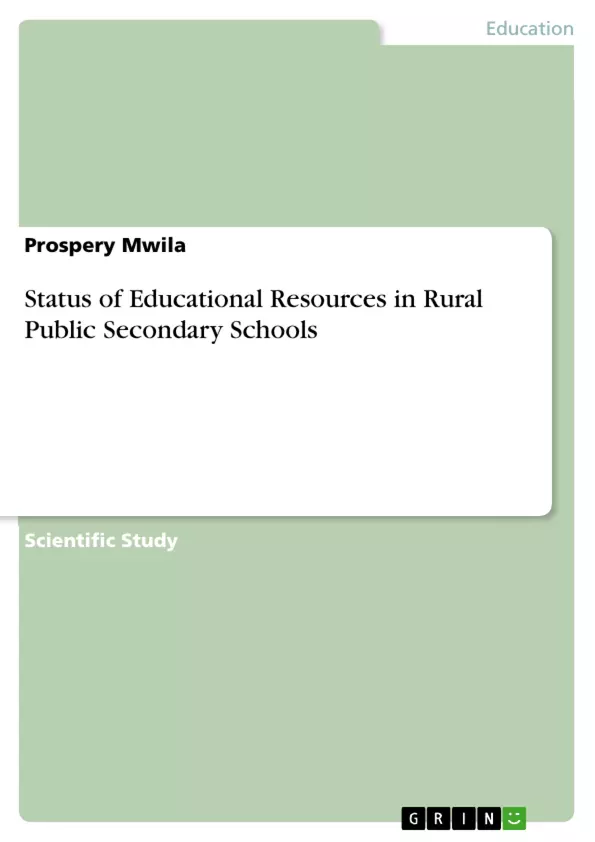Every society's quality is largely determined by the quality of its educational system. Given the apparent constraints on educational resources, the importance of maximizing their efficient utilization for maximum academic results cannot be overstated. This study assessed the status of educational resources in rural public secondary schools in Misungwi District, Tanzania.
It was guided by three specific objectives: to examine available educational resources used in teaching and learning process, to determine the distribution of educational resources in teaching and learning process and to assess the relationship between effective management of educational resources and teaching and learning process outcomes. The mixed research approach and explanatory research design was used.
Inhaltsverzeichnis (Table of Contents)
- Introduction
- Conceptualization of Resources
- Contextual Orientation
- Specific Objectives
- Literature Review
- Available Educational Resources Used on Teaching and Learning Process
- Distribution of Educational Resources in Teaching and Learning Process
Zielsetzung und Themenschwerpunkte (Objectives and Key Themes)
This study investigates the status of educational resources in rural public secondary schools in Misungwi District, Tanzania. It aims to determine the availability of these resources, their distribution, and the relationship between effective resource management and teaching and learning outcomes.
- Availability of educational resources in rural public secondary schools in Misungwi District
- Distribution of educational resources in teaching and learning process
- Relationship between effective resource management and teaching and learning process outcomes
- The role of effective management in maximizing the utilization of educational resources for positive academic outcomes
- The impact of resource availability and management on teaching and learning processes in rural schools
Zusammenfassung der Kapitel (Chapter Summaries)
- Introduction: The chapter emphasizes the crucial role of educational resources in fostering positive teaching and learning outcomes. It defines educational resources and highlights their importance in achieving educational goals. The chapter also discusses the significance of effective resource management for optimizing the learning experience.
- Conceptualization of Resources: This chapter provides a detailed definition of educational resources, encompassing both material and non-material factors that influence educational attainment. It categorizes resources into various types, including human resources, capital resources, instructional materials, academic and non-academic staff, and physical resources. The chapter further explores the concept of resource management as the process of directing daily tasks to achieve intended goals using available manpower.
- Contextual Orientation: The chapter focuses on the Tanzanian context, specifically in the Kilimanjaro region and Misungwi District. It reviews findings from previous research highlighting the importance of qualified teachers and effective resource utilization in schools. The chapter also emphasizes the need for more comprehensive studies on resource management practices in Misungwi District.
- Available Educational Resources Used on Teaching and Learning Process: This chapter presents an overview of research findings on the relationship between available educational resources and teaching and learning outcomes. It examines various studies conducted in different countries, including the USA, the United Kingdom, China, and Uganda, exploring the role of different types of resources and their impact on learning outcomes. The chapter also highlights the importance of effective resource management for maximizing their impact on the teaching and learning process.
- Distribution of Educational Resources in Teaching and Learning Process: This chapter discusses the role of financial resources in the distribution of educational resources. It draws upon research findings from the Organisation for Economic Co-operation and Development (OECD), emphasizing the importance of financial resources for teacher salaries, non-teaching staff, and purchasing necessary materials. The chapter also examines global spending patterns on education, highlighting variations in funding levels across different countries.
Schlüsselwörter (Keywords)
The main keywords and focus topics of this study include: educational resources, effective management, teaching and learning process, public secondary schools, rural areas, Misungwi District, Tanzania, resource availability, resource distribution, and student learning outcomes. The research delves into the impact of these factors on the quality of education in rural Tanzania. The study also highlights the need for efficient and equitable distribution of educational resources to optimize the learning experience for all students.
- Citar trabajo
- Prospery Mwila (Autor), 2019, Status of Educational Resources in Rural Public Secondary Schools, Múnich, GRIN Verlag, https://www.grin.com/document/1250186



